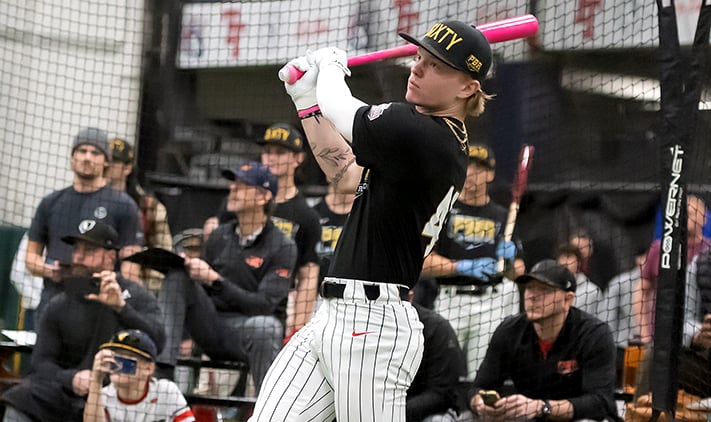2023 PBR Player of the Year: A Data Dive
July 12, 2023

Max Clark's (Franklin Community HS, 2023; Vanderbilt commit) ascent to the top of this year’s draft was not an overnight phenomenon. It was the result of years of hard work, relentless determination, and his data collected at Prep Baseball Report events helps underscore his one-of-kind track record to the top of the class.
Clark was the third overall pick in the 2023 MLB Draft, and the first high school player selected, and he was one of 43 players selected on the first day of the draft to have attended a Prep Baseball Report showcase. Clark participated in 10 PBR events from 2019 to 2023, highlighting his physical development year over year and on increasingly more prestigious stages.
In this piece, we’ll be outlining the progression Clark’s made throughout his prep career from a data standpoint, thanks in part to the measurements collected by tech partners like TrackMan and Blast Motion, among others, captured at PBR events.
Clark was just named as the 2023 PBR Player of the Year after slashing .646/.808/1.125 this past spring with nine doubles, five triples, and six home runs, driving in 33 runs and scoring 45 runs. Clark also drew 52 walks, struck out just five times, and stole 35 bases. He’s been a famous amateur player for quite some time now, and a highly touted prospect for even longer, and his rise to the top coincides with his improvements he’s demonstrated across the board.
Clark is authentically a five-tool player, but his run tool stands out as one of his very best. Clark’s speed has improved tremendously over time, as you might expect, as showcased by the graph below.
Clark now grades out as a 70 runner along the MLB scouting scale with game-changing speed that allows him to make an impact both on the basepaths and in center field. As a freshman, Clark was fast though not yet elite, even for his age, as a 7.22 runner. Over time there has been constant progression in Clark’s running ability as he lowered his 60 time to just 6.47 in two years’ time, and it's reasonable to assume it's even lower these days. Clark’s improvement over that span highlights the work ethic he’s become equally as famous for.
Clark is also well-known for his plus arm from the outfield. He’s long exhibited premium arm strength, and not just for his age, which helped him garner attention as a left-handed pitcher early in his prep career, too. In 2019, he recorded throws from the outfield as high as 85 mph, and he’s continued to make great strides since, comfortably into the plus range for pro prospects, measured as high as 92 mph in 2021. The MLB average for outfield velocity is 89.2 mph, thus Clark’s arm is already plus by MLB standards, and he has yet to fully develop physically. He will be a threat from the outfield for years to come. Pair his arm with his top-notch speed and he has the ingredients to become an elite defender in center field which has helped earn him earnest first-round consideration for the last year-plus, and it’s his bat that launched to the top of the draft.
Offensively, the left-handed-hitting Clark stands out most for his elite bat speed, contact rate, and his strength on impact. He showcased a swing change at this year’s Super 60 which allows him to have a “more free flowing load that creates quality separation and allows his barrel to get on plane deeper in the zone,” according to Cooper Trinkle, PBR Indiana lead scout. Clark recorded 16 swings from the Super 60, depicted in the graph to the right. We can see from his Blast data that he generates, on average, a bat speed of 75.9 mph, which is above the MLB average of 74 – and his max speed was measured at 78.3. Not only is Clark’s bat lightning quick, but he has deployed impressive exit velocities that complement his ability to barrel baseballs accurately and consistently.
Clark has 57 batted balls with recorded TrackMan data across both the 2023 PBR Super 60 and 2021 PBR Indiana All-State Underclass events. This graph (below) shows his exit velocity and launch angle for every batted ball. We can see that 14 of the 57 (24.6%) batted balls were barreled. This is significantly higher than the MLB average, which is around 9 percent. His ability to make solid contact is extremely impressive, and it enhances his skills in manufacturing bat speed and applying his strength upon contact.
With exceptional bat speed and an elite barrel percentage, Clark has made significant strides in his exit velocity. This improvement is evident in the graph below, which illustrates the progression of his exit velocity since his debut at the PBR event in 2019. In a mere two years, his maximum exit velocity soared from 85 mph to an impressive 103 mph, a testament to the care he has over his craft, and this strength gain goes beyond the development you'd anticipate seeing in an average high school-aged prospect. Furthermore, it's worth noting that his average exit velocity over the past few years consistently surpasses the MLB average of 89 mph, clearly demonstrating his preparedness to compete at the MLB level.
The Detroit Tigers drafted an incredible and rare talent in Clark, and if you are curious as to how he might fare at Comerica Park one day, then check out how all of his PBR batted-ball data would look at the Tigers’ home field. It’s fun to imagine how many of those balls barreled into the right-center gap he can turn into triples with his aforementioned speed, or how many doubles he can grow into home runs, given his age and the physical development he still has to undergo as his voyage into the professional ranks unfolds.
RELATED CONTENT
